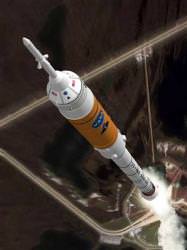NASA has discovered a potentially dangerous problem with the first stage of the Ares 1 rocket that will launch the new Orion crew capsule to the space station and to the moon. Engineers are concerned that during the first few minutes of flight, the rocket could shake violently, possibly causing significant damage to the entire launch stack. Meanwhile, nasaspaceflight.com reports that a budget review of the Constellation program found a short term deficit of $700m that will likely delay test flights and development of the yet-to-be built rockets.
The shaking problem is called thrust oscillation, and is typical in solid rocket motors. The phenomenon is characterized by increased acceleration pulses during the latter part of first-stage flight. Depending on the amplitude of these pulses, the impact on the vehicle structure and astronauts may be quite significant.
The Associated Press reported that NASA discovered the problem in the fall of 2007, but did not discuss the problem publicly until January 18, 2008 after the AP filed a Freedom of Information Act request and Keith Cowing of NASAWatch.com submitted detailed engineering questions regarding the oscillations.
In the response given to both NASAWatch and AP, NASA said they are working to understand how the thrust oscillation may impact the entire stack – the Ares first stage, upper stage and the Orion crew vehicle — and to determine how to minimize the impact. They have brought in experts from within NASA and outside industry to review the issues and to determine if lessons learned from previous launch vehicles will help solve the problems. NASA said they are studying multiple systems to identify all possible scenarios.
“This is a development project like Apollo. I hope no one was so ill-informed as to believe that we would be able to develop a system to replace the shuttle without facing any challenges in doing so,” NASA Administrator Mike Griffin said in a separate statement to the Associated press. “NASA has an excellent track record of resolving technical challenges. We’re confident we’ll solve this one as well.”
The first stage is a single, five-segment reusable solid rocket booster derived from the Space Shuttle solid rocket motors developed and produced by ATK Launch Systems.
The Ares I rocket is the core of the new space transportation system that will carry crewed missions back to the moon, and possibly on to Mars. The rocket may also use its 29-ton payload capacity to deliver resources and supplies to the International Space Station.
Concerning the problems of budget shortfalls, Ares program managers have offered a re-aligned development and test flight schedule in an attempt to protect Orion’s debut mission to the ISS in 2015.
The reason for the changes relates to additional costs associated with the challenges of Ares I’s development, creating a shortfall of funds for the financial year period 2008 to 2010.
Among numerous changes, a test flight of the Ares I originally scheduled for 2012 has been delayed by a year, while test flights with the Orion crew vehicle will possibly delayed between nine and three months. The Ares V’s lunar mission debut will now be an unmanned fly-by, according to nasaspaceflight.com.
Original New Sources: Associated Press, nasaspaceflight.com

